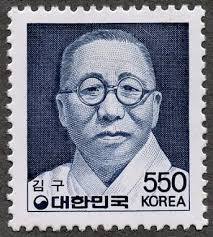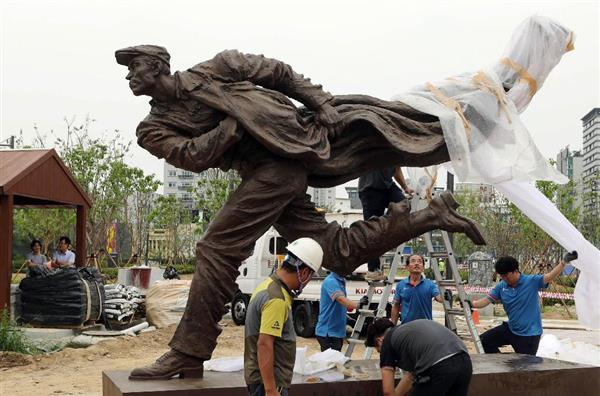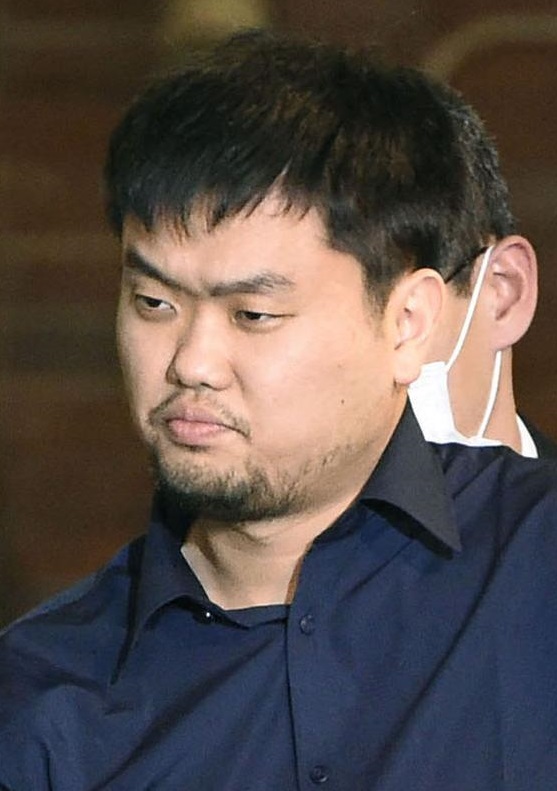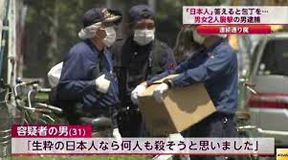Terrorists on postage stamps
/
What he was? |
What has he done?
|
Details
|
Other |
Kim Koo
金九
(1876-1949)
 |
|
|
|
Kim as the robbery and
murder.
|
In February 1896, Kim
killed a Japanese trader and stole his money and other valuables
before fleeing in Hwanghae Province, Korean Peninsula(Chihapo
Incident).
|
Kim argued in his
autobiography that this Japanese was a Japanese army lieutenant. But
this Japanese was a trader in fact.
He was arrested on burglary
and murder, and imprisoned but broke prison.
|
The depiction of this crime in his autobiography reveals his abnormal mentality
and brutality. And he called the victim "Wenomu" which was derogatory
term often used by Korean people when referring to Japanese.
"I slashed the whole body of
"Wenomu" from head to foot. It happened at dawn of day. it was cold.
Blood streamed on the ice-glazed ground as fountain. I took a slip
of blood from my palms, and drank this blood of "Wenomu". Then
I daubed the blood of
"We" onto
my
face...
|
Kim as the mastermind of major terrorism incidents of
the time.
|
Kim
led such terrorism incidents of the time as the bombing incident in
Shanghai(1932), Sakuradamon Incident(1932) and others.
|
After 1919
in Shanghai
Kim joined terrorist group(the Provisional Government of the Republic
of Korea). Kim became the president of this organization in
1927. He led terrorism incidents as the leader of this
group.
He formed anti-Japanese armed
organization, "Korean Patriotic Organization" for the purpose of
it.
|
In June 1949,
Kim was assassinated. Many people think this was due to a
conflict with Rhee Syngman (the 1st president of Korea).
In 1962, Korea
conferred Order of Merit for National Foundation on him.
In 1986, Korea issued 450-won stamp.
In 1988, Korea issued 550-won stamp.
Both stamps have his portraits.
In 1993, North Korea
also issued six commemorative stamps of "Korea reunification
laureate". which had his portraits.
(note1)
|
An Jung-geun
安重根
(1879-1910)

Assassin |
In October
1909, An shot Ito Hirofumi dead in Manchuria. Ito was a
a
four-time Prime
Minister of Japan and former Resident-General of Korea.
|
Ito
Hirofumi was the most influential politician who was against the
Japan's annexation of the Korean Peninsula. This means An made
the biggest mistake as long as possible.
But such a thing is not
written in Korean text book.
Just before Ito's
death, Ito murmured "He was a fool." after hearing an assassin was a Korean.
In March 1910, he
was executed at Lushun prison for murder.
|
An paid respect to Emperor Meiji, and he
was never an anti-Japanese
person.
The submarin of Korean Navy, which took the
water in June 2008, was given his name.

Recently(in August,2017) An Jung-Geun Statue(↑)
was placed at the park in front of the station in Uijeongbu, Korea.
This statue, which was donated by China, was created based on the
image that he took out a gun just before committing his crime. This
is very suitable for a terrorists state. So Korea is erecting such
statue that is tantamount to encourage terrorist acts, even now.
This is just one of many evidence that Korea is the nation which
affirms terrorism.
Additionally, another An
Jung-Geun Statue was producted and will be placed at An's memorial
hall near the Harbin Station, the crime
scene.
|
Lee Bong-chang
李奉昌
(1900-1932)

Assassin(abortive
attempt) |
In January
1932, at the Sakuradamon (櫻田門) gate of Tokyo's Imperial Palace, Lee
Bong-chang hurled a hand grenade at the emperor's horse
carriage. |
In 1931 he joined an anti-Japanese
armed organization, "Korean Patriotic Organization", which was organized and led by
Kim Koo. He prepared for this terrorist attack.
In this
terrorism incident, one of guards was slightly injured,
but Emperor Shouwa escaped harm. Lee was arrested on the spot.
This incident was treated as a high treason, and he was executed at
at Ichigaya prison
in October
1932.
|
In 1962, Korea
conferred Order of Merit for National Foundation on him.
In 1992,
Korea issued 100-won stamp to mark the 60th anniversary of his
death.
|
Yun Bong-gil
尹奉吉
(1908-1932)

Assassin
|
In April 1932, Yun
threw a bomb onto Japanese dignitaries at the Emperor's Birthday
celebration in Shanghai. Two persons were killed and many people
were injured either slightly or
seriously.
|
In 1931, he joined an
anti-Japanese armed organization, "Korean Patriotic Organization",
which was organized and led by Kim Koo. He prepareed for this
terrorist attack.
Immediately after this incident, Yun tried to kill
himself by another bomb. But It did not explode and he was arrested
on the spot.
After court-martial,
he was executed by firing squad at Kanazawa prison in December,
1932.
|
He was posthumously awarded
the Republic of Korea Medal of Order of Merit for National Foundation
in 1962 by the Korean
government.
He is enshrined in the independence hall of Korea.
The submarin of
Korean Navy, which took the water in July 2014, was given his
name.
 His statue in Seoul also captures the moment of his crime. We can learn how Korean people love terrorism. This
is suitable for a terrorists state, too.
His statue in Seoul also captures the moment of his crime. We can learn how Korean people love terrorism. This
is suitable for a terrorists state, too.
|












 His statue in Seoul also captures the moment of his crime. We can learn how Korean people love terrorism. This
is suitable for a terrorists state, too.
His statue in Seoul also captures the moment of his crime. We can learn how Korean people love terrorism. This
is suitable for a terrorists state, too.